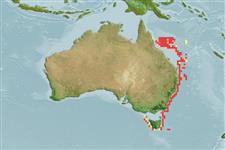Elasmobranquios (tiburones y rayas) (sharks and rays) >
Rajiformes (Skates and rays) >
Rajidae (Skates)
Etymology: Dipturus: Greek, di = two + Greek, pteryx = fin (Ref. 45335); wengi: Named for Mr. Herman Weng, a Queensland fisheries biologist..
More on authors: Séret & Last.
Environment: milieu / climate zone / depth range / distribution range
Ecología
marino bentopelágico; rango de profundidad 486 - 1049 m (Ref. 75647), usually 600 - 1000 m (Ref. 114953). Temperate; 16°S - 44°S, 143°E - 156°E (Ref. 114953)
Western Pacific to Southwest Pacific: Queensland to Tasmania (Australia) (Ref. 114953).
Tamaño / Peso / Age
Maturity: Lm ? range ? - ? cm
Max length : 112 cm TL macho / no sexado; (Ref. 75647); 128.0 cm TL (female)
Occurs on the continental slope off tropical and temperate eastern Australia (Ref. 75647). Adults mainly feed on bony fishes (Ref. 114953). Lengths of adolescent males recorded 108.1-112.2 cm TL, smallest juvenile 25.2 cm TL (Ref. 75647).
Life cycle and mating behavior
Madurez | Reproducción | Puesta | Huevos | Fecundidad | Larva
Seret, B. and P.R. Last, 2008. A new Australian skate of the genus Dipturus (Rajoidei: Rajidae). In Last, P.R., W.T. Whiteman, J.J. Pogonoski and D.C. Gledhill (eds.) : Description of new Australian skates (Batoidea: Rajoidei) pg. 99-108. CSIRO marine and atmospheric research paper no. 021. (Ref. 75647)
IUCN Red List Status (Ref. 130435)
Threat to humans
Harmless
Human uses
Más información
Nombres comunesSinónimosMetabolismoDespredadoresEcotoxicologíaReproducciónMadurezPuestaAgregación para la puestaFecundidadHuevosEgg development
Age/Size
Crecimiento
Length-weight
Length-length
Length-frequencies
Morfometría
Morfología
Larva
Dinámica larvaria
Reclutamiento
Abundancia
BRUVS
ReferenciasAcuiculturaPerfil de acuiculturaRazasGenéticaElectrophoresesheritabilidadEnfermedadesProcesamientoNutrientsMass conversion
ColaboradoresImágenesStamps, Coins Misc.SonidosCiguateraVelocidadTipo de nataciónSuperficie branquialOtolitosCerebrosVisión
Herramientas
Special reports
Download XML
Fuentes de Internet
Estimates based on models
Preferred temperature (Ref.
123201): 1.9 - 8.7, mean 6.7 °C (based on 239 cells).
Phylogenetic diversity index (Ref.
82804): PD
50 = 0.5000 [Uniqueness, from 0.5 = low to 2.0 = high].
Bayesian length-weight: a=0.00282 (0.00133 - 0.00596), b=3.25 (3.08 - 3.42), in cm total length, based on LWR estimates for this Genus-body shape (Ref.
93245).
Nivel trófico (Ref.
69278): 3.9 ±0.6 se; based on size and trophs of closest relatives
Resiliencia (Ref.
120179): Muy bajo, población duplicada en un tiempo mínimo superior a 14 años (Preliminary K or Fecundity.).
Fishing Vulnerability (Ref.
59153): Very high vulnerability (77 of 100).
